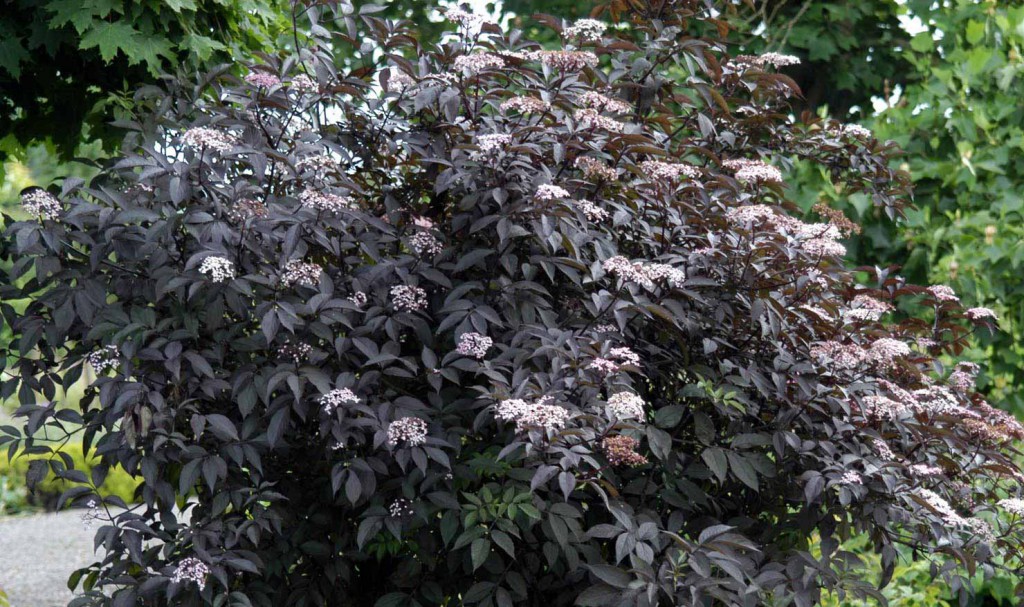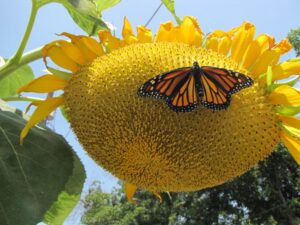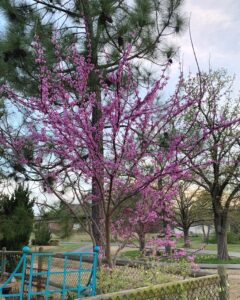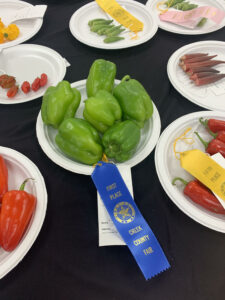Kathy Berryhill
Creek County Master Gardener
New spring color is a feast for the eyes. After months of a mostly brown landscape, the appearance of bright yellow blooms on daffodils and forsythia along with the coral blooms on quince whet our appetite for the color show that will soon follow. During winter, evergreens stand out due to their texture and varied shades of green. But as the deciduous plants begin growing their leaves, many other options are available that can add visual interest to the landscape with a more vibrant foliage. Properly placed, shrubs with colored foliage can dress up foundation plantings and add interest to flowerbeds. While some shrubs like the crepe myrtle provide color shows when in bloom, the deeply colored foliage of the Black Elderberry adds interest to the landscape throughout the growing season.
Black Beauty Elderberry (Sambucus nigra Black Beauty): Elderberry has a special place in my heart. My mother’s name was Elda and she would always remind people to remember her name in connection with the word elderberry! I was so pleased then when I found the cultivar Black Beauty Elderberry and added it to my yard. Plants that have a story associated with them or bring back a memory of a loved one are a bonus for a gardener. As the name suggests, the Black Beauty foliage is a deep, dark purplish-black. After the initial leaves appear in spring, beautiful pink flowers follow in early summer. The color of the lighter flowers provides a striking contrast to the dark foliage.

The Black Beauty Elderberry is a tough, durable plant that grows well in a range of soil conditions. It does require adequate moisture and also benefits from well-drained soil. The sweet anise fragrance of the flowers attracts birds and pollinators. Being deer resistant makes it a good fit in many landscapes.
When planting, allow extra space as this shrub can grow to 8’-12’ with a similar spread. Although the plant specifics say it can take full sun, it is probably better placed in part sun in our climate. Keep in mind the large growth habit of this plant and allow proper spacing to promote good air circulation. As with most plants, adding mulch after planting is beneficial. Always keep the mulch 4”-6” away from the main stems to help prevent fungal disease in the trunk. With adequate mulch, care and moisture, the Black Elderberry can withstand the cold hardness of USDA Zone 4, which is rated -10 degrees to -20 degrees. If the last two winters with their cold extremes are an indicator of winters to come, purchasing more cold-hardy plants should be a wise choice.
Spring is a good time to plant most anything, but the Black Beauty Elderberry will especially benefit from an early planting. After planting, fertilize in early spring when the new buds begin to swell with a 10-10-10 fertilizer to help strengthen the plant and encourage growth and hardiness. Repeat the fertilization after the fruit sets. Monitoring for aphids and spider mites is needed but I found that using Neem Oil spray easily controls the infestation. Like other flowering shrubs, the Black Elderberry blooms on old wood. So pruning after the blooms have faded is recommended. A companion planting of the Black Lace Elderberry will produce edible fruit through cross-pollination.
Black Elderberry flowers and berries are edible and provide high doses of Vitamin C. The blackish-red berries can be used in anything from jams to wine and contain more vitamin C than oranges. In fact, the flowers are often used to create teas and even liquors. Please note that the stems, leaves and unripe berries are toxic and should not be consumed. Additionally, other varieties of elderberry have toxic berries whether ripe or unripe.
Black Lace Elderberry (Sambucus nigra Black Lace): In the same family as the Black Beauty Elderberry, the Black Lace Elderberry is a smaller plant. It resembles a Japanese Maple with finely cut, lace-like leaves. As my yard is quite sunny, the Black Lace Elderberry would be better suited than the shade-loving Japanese Maple. The Black Lace Elderberry is a smaller plant than the Black Beauty Elderberry as it grows only to a height of 6’-8’ with a similar width. A companion planting of the Black Beauty Elderberry will produce edible fruit through cross-pollination.
Both of these shrubs can be found at local nurseries and would make a beautiful addition to any landscape!
Happy Gardening!










